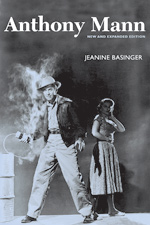(Wesleyan, 240 pages, $27.95)
By Jeanine Basinger
 If Anthony Mann had chosen a better time to die, his reputation as one of America’s great filmmakers might have been more assured. As it was, he left us in 1967, at the very dawn of serious academic film studies in the United States. He gave a few short interviews in his last years, but death denied him a fuller say in the cementing of his own reputation. That job of reclamation and rehabilitation fell to Wesleyan University’s Jeanine Basinger who in 1979 published this landmark auteurist study. It remains the only serious book-length study of Mann’s work available in English. Its reissue in an expanded, restored and updated edition is a cause for major celebration.
If Anthony Mann had chosen a better time to die, his reputation as one of America’s great filmmakers might have been more assured. As it was, he left us in 1967, at the very dawn of serious academic film studies in the United States. He gave a few short interviews in his last years, but death denied him a fuller say in the cementing of his own reputation. That job of reclamation and rehabilitation fell to Wesleyan University’s Jeanine Basinger who in 1979 published this landmark auteurist study. It remains the only serious book-length study of Mann’s work available in English. Its reissue in an expanded, restored and updated edition is a cause for major celebration.
Basinger breaks down Mann’s career into three distinct phases: his postwar black-and-white work with pioneering film noir cinematographer John Alton; his widescreen Technicolor Westerns with Jimmy Stewart in the 1950s, in which human psychosis plays out against spectacular western landscapes; and his late period epics, including genre highlights such as El Cid and The Fall of the Roman Empire.
Basinger doesn’t discount the impact of Mann collaborators like Alton or writers Borden Chase and Philip Yordan, but her deep reading of Mann’s body of work discerns a continuity of vision and technique that pulses through his entire career. The script is simply the starting point for Mann; it is usually lighting, composition, framing and other directorial embellishments that make his movies truly distinctive. Basinger explores the constant rearrangement of figures in the frame to delineate power relations among characters; the aggressive use of chiaroscuro to conceal and reveal information and to intensify suspense; and what she calls his “arhythmic editing style.” All these are aspects of Mann’s integrated, coherent and instantly recognizable signature, which never degenerated into mere stylistics. Though his movies look and feel original and powerful, Mann’s artistic choices were always in service of the story.
Alongside the three main periods of the career, Basinger finds room for fascinating oddities like The Tall Target, Men at War and God’s Little Acre, and fascinatingly flawed transitional works like the 1950 oedipal-noir Western The Furies and the 1960 epic-Western Cimarron. She has revisited every movie directed in full or in part by Mann, and her richly detailed and persuasive formal analyses repeatedly yield new and invigorating insights. This is the way all great directors’ careers should be examined, though it’s possible that many of their oeuvres might not stand the pressure as well as Mann’s.
Review written by John Patterson.